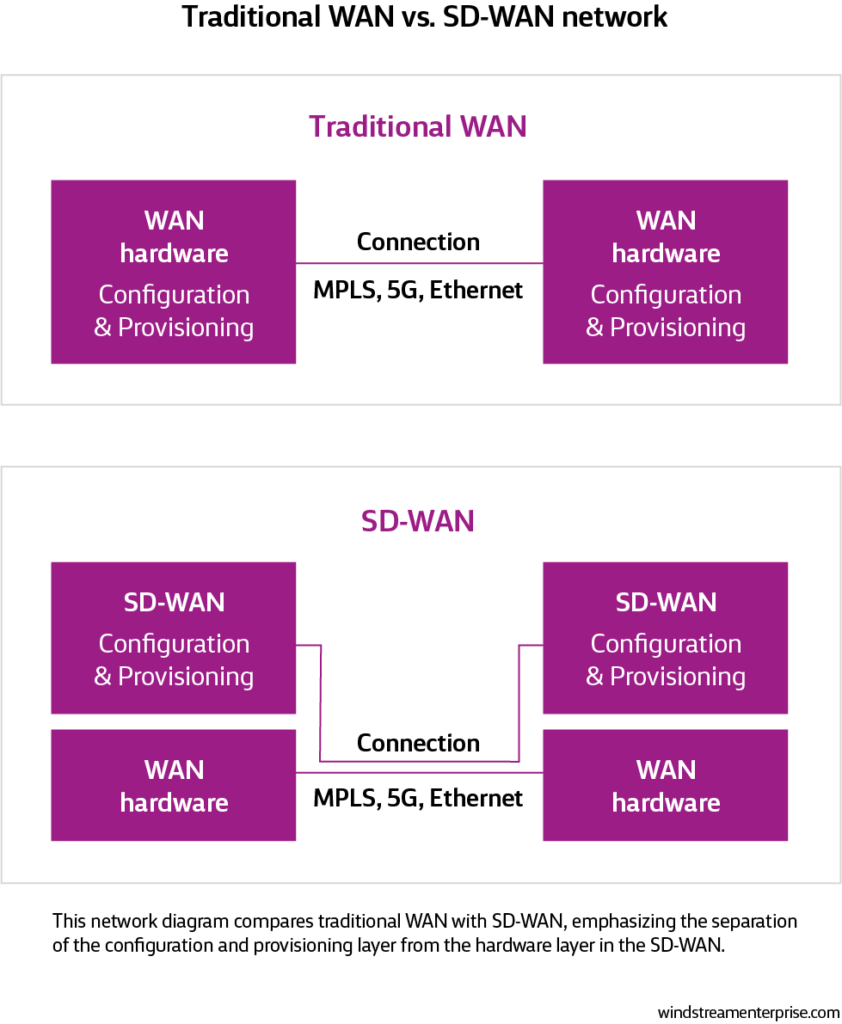DIY vs. managed SD-WAN: How to choose the best approach
8 minute read time
Implementing a software-defined wide area network (SD-WAN) involves many factors, including design, implementation, ongoing optimization and management. Once you decide to adopt SD-WAN and you have aligned with your buying committee, you’ll need to determine who will design, procure, install and ultimately manage your solution—your in-house IT team or a managed service provider.
As enterprise IT departments grapple with SD-WAN migration, they often seek guidance on implementation decisions. To that end, let’s discuss the pros and cons of Do-It-Yourself (DIY) versus managed SD-WANs—specifically, what implementing SD-WAN yourself versus using a service provider means for you and your team.
The difference between a traditional WAN and SD-WAN

In a distributed enterprise network, traditional multi-protocol label switching (MPLS) connects each site to a private WAN infrastructure, typically using a dedicated leased line from a single carrier. An SD-WAN usually includes multiple, diverse connections at each site from (potentially) multiple carriers.
Since MPLS converges voice and data traffic over dedicated connections, any changes to bandwidth needs and upgrades must be performed manually on hardware routers at each site. SD-WAN is an application-aware service that uses a virtualized infrastructure that isolates the control layer from the physical hardware layer. Changes in bandwidth demand occur automatically, while configuration and provisioning can be done on a centralized controller.
For a deeper dive on the differences between MPLS and SD-WAN, see SD-WAN vs. MPLS: What’s the Difference and Which Is Better?
Implementing SD-WAN: Things to consider
The decision to partner with a managed service provider or implement SD-WAN yourself can have a significant impact on the speed and ease of your company’s migration. The decision whether to do it yourself or partner with someone comes down to two factors: expertise and budget.
Expertise
In contrast to MPLS, SD-WAN is a completely different networking model. Software-based infrastructure demands specialized in-house skill sets for design, deployment, management and maintenance that many companies lack.
In addition, some IT decision makers have difficulty adjusting to the dispersion of network services, like optimization services, that used to be located in data centers. The uncertainty increases when it comes to managing security and understanding the role of third-party solutions. Ultimately, the IT leader shoulders the full responsibility for stitching together a solution.
Budget
Like any network, SD-WAN requires a capital outlay. IT leaders are responsible for procuring SD-WAN hardware and software directly from vendors and directing their internal teams to deploy and manage the system. While this approach offers an IT leader the chance to build a best-in-class solution that’s aligned with the organization’s goals, the vetting and selection process can take significant time and money.
Once SD-WAN appliances reach end-of-life, self-managed solutions will require additional investment and on-site redeployments. Similarly, IT is solely responsible for ongoing upgrade and repair tasks that require dedicated resources. There are no SLAs when purchasing and managing the services yourself.
By contrast, a managed service agreement entails the service provider’s responsibility for upgrades, maintenance and service levels.
SD-WAN as a service
The as-a-service option is a variation on a do-it-yourself SD-WAN. This entails approaching either a value-added reseller (VAR) or an SD-WAN vendor directly for network elements and software.
SD-WAN solutions offered by single vendors may reduce some of the complexity associated with setting up the network, but the IT manager—and the business—are limited by the native capabilities of the hardware and software. Depending on the business’s particular requirements, these capabilities may not be sufficient. Further, standard SD-WAN controllers provide limited insights into network performance, including early warnings of potential outages.
Evaluate your in-house SD-WAN capabilities
For a more complete list of questions on how to evaluate your in-house capabilities for adopting SD-WAN, see SD-WAN best practices: 5 Ws for a successful implementation.
Reasons why organizations buy fully managed SD-WAN
Choosing to work with a managed services provider offers numerous advantages to corporate IT departments. For one, it allows IT managers to focus their scarce resources on adding value to the business. According to a survey by Frost & Sullivan1, the majority of companies surveyed preferred to work with a managed service provider to migrate to SD-WAN. The following graphic sums up the key reasons why.

What to look for in a managed SD-WAN provider
A third-party service provider with a proven track record of successful deployments can bolster your IT team by facilitating access configuration, bandwidth prioritization and endpoint installations to help ensure your project stays on track and on budget. Here are some helpful best practices to follow in your managed SD-WAN provider search.
-
Core competencies
Is the service provider deeply rooted in legacy technologies or do they live and breathe cloud-ready solutions?
-
Experience with SD-WAN implementations
Does the provider have a volume of successful deployments that span geography, size and vertical?
-
Credibility of provider
Is the vendor well-regarded and recognized in the industry for SD-WAN? Do analysts agree?
-
Single pane of glass portal
Does the vendor’s SD-WAN management portal offer deep network visibility and holistic control? Is it easy to use? Does it offer actionable insights on issues and performance optimization?
-
Right-fit solutions
Does the provider offer expert guidance, choice of solutions and contract terms to fit your needs today and scale with your ambitions?
-
Professional services
Does the provider offer professional services or white-glove options to assist with inventory and migration planning, implementation and configuration?
Wrapping up: DIY or managed SD-WAN?
SD-WAN Concierge™ from Windstream Enterprise ensures you get the right SD-WAN solution the first time. We have partnered with three of the leading SD-WAN technology providers, VMware, Fortinet and Cato Networks, to offer an award-winning SD-WAN solution that’s right for your business. SD-WAN Concierge features an intuitive single-pane-of-glass management portal.
If you want to read about some successful implementations, check out these SD-WAN case studies in key industries including healthcare, financial services and retail.
Citations
- Frost & Sullivan, 2018 U.S. SD-WAN End-User Survey Analysis, December 2018. Accessed 1/12/22.